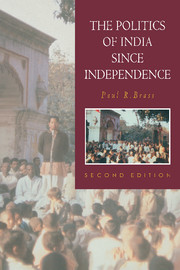Book contents
- Frontmatter
- Dedication
- CONTENTS
- List of figures and tables
- Preface
- List of abbreviations
- 1 Introduction: continuities and discontinuities between pre- and post-Independence India
- PART I POLITICAL CHANGE
- PART II PLURALISM AND NATIONAL INTEGRATION
- PART III POLITICAL ECONOMY
- Introduction
- 8 Politics, economic development, and social change
- 9 Political aspects of agricultural change
- 10 Conclusion: problems and prospects
- Bibliography
- Index
10 - Conclusion: problems and prospects
Published online by Cambridge University Press: 05 February 2015
- Frontmatter
- Dedication
- CONTENTS
- List of figures and tables
- Preface
- List of abbreviations
- 1 Introduction: continuities and discontinuities between pre- and post-Independence India
- PART I POLITICAL CHANGE
- PART II PLURALISM AND NATIONAL INTEGRATION
- PART III POLITICAL ECONOMY
- Introduction
- 8 Politics, economic development, and social change
- 9 Political aspects of agricultural change
- 10 Conclusion: problems and prospects
- Bibliography
- Index
Summary
THE PROBLEM OF THE PERSISTENCE OF THE PARLIAMENTARY SYSTEM
India is virtually unique among contemporary post-colonial countries in having functioned since Independence, with the exception of the Emergency, with a parliamentary system modeled on the British form of government. India's parliamentary system has evolved from one in which the Cabinet and the Prime Minister were dominant and the President was a figurehead – though potentially important — into a form of prime ministerial government, in which both the Parliament and the Cabinet play a secondary role. The specific role of each Prime Minister and the relationship between the Prime Minister and other central government institutions and forces has varied somewhat, but one can also see an evolution over the past forty-five years. Nehru's period was one of prime ministerial government in which the Cabinet played an important role as well and Parliament was a place where opinions were expressed but little real power was exercised. Under Shastri, the influence of the Cabinet declined and that of the Prime Minister's Secretariat increased, a trend which continued under Mrs. Gandhi. However, there was a further shift under Mrs. Gandhi's leadership away from reliance upon any of the formal channels of authority in the system to dependency upon a narrow clique of personal advisers accountable only to the Prime Minister herself. Rajiv Gandhi continued his mother's pattern so that, in effect, prime ministerial government moved a further step toward a form of personal authority in which succession was dynastic and rulership was conducted with the counsel of a virtual princely court, and in which both Cabinet and senior bureaucrats were reduced in importance.
During the Janata period, an entirely different pattern, based on a form of coalition politics, developed in which the Prime Minister was only primus inter pares in a divided government, which ultimately fell in a Parliament that came to reflect the divisions within the Cabinet and for a brief period exercised indirectly its ultimate power of granting or withholding confidence in the government of the day. That pattern was repeated in the rise and fall of the National Front government of V. P. Singh.
- Type
- Chapter
- Information
- The Politics of India since Independence , pp. 336 - 367Publisher: Cambridge University PressPrint publication year: 1994

